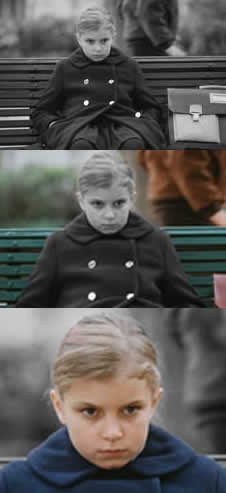 When <b>Julie Gavras</b>, writer-director of <b><i>Blame It on Fidel</b></i>, was ten years old, her family was vacationing in Mexico while her father, Costa-Gavras, Oscar-winning filmmaker of <i>Z</i> (1968), was making <i>Missing</i> (1982), based on the true story of an American journalist who disappeared during Pinochet’s coup d’état in Chile. “It was my political awakening,” Julie Gavras has said. “Observing my father on the set, I learned what a military junta was… and I started understanding politics.”
When <b>Julie Gavras</b>, writer-director of <b><i>Blame It on Fidel</b></i>, was ten years old, her family was vacationing in Mexico while her father, Costa-Gavras, Oscar-winning filmmaker of <i>Z</i> (1968), was making <i>Missing</i> (1982), based on the true story of an American journalist who disappeared during Pinochet’s coup d’état in Chile. “It was my political awakening,” Julie Gavras has said. “Observing my father on the set, I learned what a military junta was… and I started understanding politics.”
So when she adapted Domitilla Calamai’s 2006 novel, Tutta Colpa di Fidel for the screen, she decided to focus the story (originally set between 1968 and the early 1970s) on 1970-71 and to incorporate Chile into the screenplay. Gavras had been making documentaries, and her 2002 film, The Pirate, the Wizard, the Thief, and the Children concerned a class of nine-year-olds making a film at school. This work prepared her for her feature debut and the auditioning of over 400 girls in six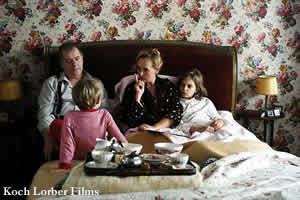 months to find Nina Kervel as her nine-year-old “leading lady.” Blame It on Fidel unspools from her character’s point of view, and the director tells us that this narrative choice puts the movie-goer in a special place: “We watch a little girl watching the world around her… and by seeing how she reacts, we understand how she misunderstands. This leads to strange confrontations between what she thinks and what adults impose on her. It allows us to play off the excesses on both poles of the story.” The film is a reflection on political commitment and the discovery of new values, and just as these are a jolt for Anna, they give her parents a bumpy ride as well.
months to find Nina Kervel as her nine-year-old “leading lady.” Blame It on Fidel unspools from her character’s point of view, and the director tells us that this narrative choice puts the movie-goer in a special place: “We watch a little girl watching the world around her… and by seeing how she reacts, we understand how she misunderstands. This leads to strange confrontations between what she thinks and what adults impose on her. It allows us to play off the excesses on both poles of the story.” The film is a reflection on political commitment and the discovery of new values, and just as these are a jolt for Anna, they give her parents a bumpy ride as well.
We never see South America in Blame It on Fidel, although the film ends with memorable footage from Patricio Guzman’s Battle of Chile in which President Allende salutes his people from a balcony with the enemy’s tanks on his heels. Nor do we see Fidel in Julie Gavras’ film, so much as a Cuban-exile nanny, Filomena, who despite herself, wreaks havoc on the little girl’s sense of stability. What we do see is one story of one family’s coming to terms with what Allende stood for — and not vis-à-vis the hidden politics and covered-up history that Costa-Gavras confronted in Missing, but rather in the candid and vociferous, if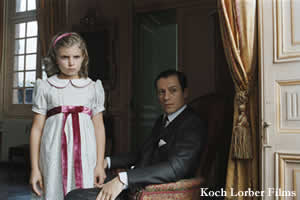 occasionally gawky, daily maneuvers of the intellectual De la Mesa family in Paris.
occasionally gawky, daily maneuvers of the intellectual De la Mesa family in Paris.
At a wedding reception on the grounds of a Bordeaux vineyard in 1970, nine-year-old Anna prances like a princess, donning her aunt’s bridal veil and mimicking the guests with their properly-affected sipping of champagne and polite kisses. Wise beyond her years and stridently confident, she can’t be bothered with the 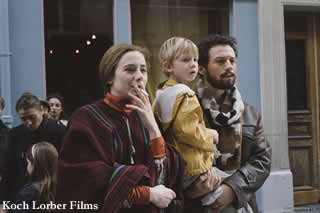 other children’s cat and mouse games, preferring to eavesdrop her way into a serious conversation where the only barrier is the Spanish her father, Fernando, speaks with his militant sister, Marga. Fernando has smuggled Marga and her daughter, Pilar, out of Spain upon the death of Marga’s husband at the hand of Franco. When Marga and Pilar, Anna’s age, are invited to live with Fernando, a trial attorney, and Anna’s mother Marie, a journalist for a women’s magazine, in their spacious home with a garden, Anna turns up her nose. More important, the new living arrangement gives rise to a deep-rooted shame in Fernando for never having taken a stand against Franco, and before we can say “¡Caramba!”, A-student Anna is pulled out of her divinity class at her Catholic school, her parents are off to Chile to support Allende for President, and they take up a smaller and humbler apartment upon their return. Filomena is replaced by Panayota, a Greek exile, with her women-centered creation myths of goddess Gaia, and then by Mai Lahn from Vietnam, with her fables of animals speaking in one voice as they appeal to the Rain
other children’s cat and mouse games, preferring to eavesdrop her way into a serious conversation where the only barrier is the Spanish her father, Fernando, speaks with his militant sister, Marga. Fernando has smuggled Marga and her daughter, Pilar, out of Spain upon the death of Marga’s husband at the hand of Franco. When Marga and Pilar, Anna’s age, are invited to live with Fernando, a trial attorney, and Anna’s mother Marie, a journalist for a women’s magazine, in their spacious home with a garden, Anna turns up her nose. More important, the new living arrangement gives rise to a deep-rooted shame in Fernando for never having taken a stand against Franco, and before we can say “¡Caramba!”, A-student Anna is pulled out of her divinity class at her Catholic school, her parents are off to Chile to support Allende for President, and they take up a smaller and humbler apartment upon their return. Filomena is replaced by Panayota, a Greek exile, with her women-centered creation myths of goddess Gaia, and then by Mai Lahn from Vietnam, with her fables of animals speaking in one voice as they appeal to the Rain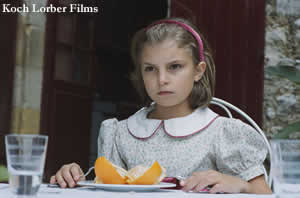 Genie for water. Fernando soon fills the living room long into the night with strategizing barbudos (bearded “reds,” as Filomena refers to them, who are always on the move and fear no God) just as her mother brings advocates for women’s reproductive rights to their dining-room table to audiotape their woes over heavy words like “abortion.”
Genie for water. Fernando soon fills the living room long into the night with strategizing barbudos (bearded “reds,” as Filomena refers to them, who are always on the move and fear no God) just as her mother brings advocates for women’s reproductive rights to their dining-room table to audiotape their woes over heavy words like “abortion.”
These are major adjustments for Anna after residing at her granny’s chateau where she learns to simply donate old clothes to the poor and treat them politely. In fact her granny, under fire with persistent probing from Anna, retorts that communists are people “who want everything — our houses, our vines, our clothes, our money, and your toys!” To be fair, she starts out explaining that communists are “students, workers, people like everyone else, but most of them are poor…” We don’t see these people in the film until Fernando and Marie, against Marga’s advice, take Anna and her little brother to the streets with them on a demonstration against Franco to 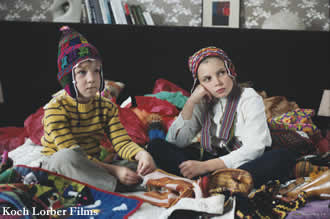 show their children “group solidarity,” a term Anna resists for the longest time given that the event leads to smoke bombs and tear gas. But we do see a cross-section of women, little by little, filling Marie’s life as she shifts her writing from fluff pieces for Marie Claire to meticulous accounts of women who join her in resisting France’s 1920 law against women’s reproductive rights. Ultimately, a bold action within this struggle poignantly shores up issues between Marie and Fernando that Anna witnesses and interrogates with astounding maturity. As she protests her parents’ virulent political squabbling, the camera tracks her taking off in a huff over the city streets, her little brother in tow, ‘til she lands at the library, content to seek her own answers in geography books on Chile, Cuba, and Spain alike. Communism… abortion… Precocious thinker that Anna is, the liveliness of the film is her running pall-mall into the disturbing question of what can and can’t be said. “It’s always better to talk,” her mother tells her. “That’s not your problem. You’re a big talker.”
show their children “group solidarity,” a term Anna resists for the longest time given that the event leads to smoke bombs and tear gas. But we do see a cross-section of women, little by little, filling Marie’s life as she shifts her writing from fluff pieces for Marie Claire to meticulous accounts of women who join her in resisting France’s 1920 law against women’s reproductive rights. Ultimately, a bold action within this struggle poignantly shores up issues between Marie and Fernando that Anna witnesses and interrogates with astounding maturity. As she protests her parents’ virulent political squabbling, the camera tracks her taking off in a huff over the city streets, her little brother in tow, ‘til she lands at the library, content to seek her own answers in geography books on Chile, Cuba, and Spain alike. Communism… abortion… Precocious thinker that Anna is, the liveliness of the film is her running pall-mall into the disturbing question of what can and can’t be said. “It’s always better to talk,” her mother tells her. “That’s not your problem. You’re a big talker.”
It is to Gavras’ credit that Blame It on Fidel is as affectionate as it is politically astute, not just in the range of heavy ideologies the film takes on — fascism, socialism, imperialism, feminism — but in the patience with which it watches its characters balk and stumble, contradict themselves and learn from their lapses and confrontations. In this film, politics is not just about leaders, regimes, or even dates, like May ’68 or September 11, 1973, but also the daily decisions made on-the-spot in the kitchen, the car, the school, the clinic, the playground. And Anna gravitates to their helm, though her ever-adamant face is more a figurehead to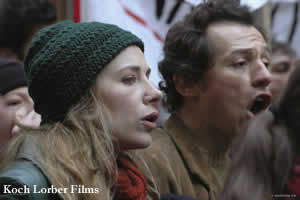 the wind. Just as this petite haute-bourgeoise fights for stability amidst relentless change, she also demands certainty. This film’s brand of voyeurism is a little girl’s peering into the cracks in her parents’ behavior that could make them hypocrites like their own parents. “So before, you were wrong?” she accuses, having overheard a quarrel exposing her father’s inertia in resisting Franco, and he answers, “Not completely — I made a family with two fine kids.”
the wind. Just as this petite haute-bourgeoise fights for stability amidst relentless change, she also demands certainty. This film’s brand of voyeurism is a little girl’s peering into the cracks in her parents’ behavior that could make them hypocrites like their own parents. “So before, you were wrong?” she accuses, having overheard a quarrel exposing her father’s inertia in resisting Franco, and he answers, “Not completely — I made a family with two fine kids.”
Anna sniffs out the inconsistencies that jar her personal world order, but she also sifts through the social and political mysteries that would offer invaluable answers, tentative as they might be. To see her feathers ruffled by a perplexing turn of events or a seeming oxymoron is to see her face screw itself into a whole jungle gym of thoughts and come out the other side of it. Nina Kervel’s visage is an ever-turning kaleidoscope doing the mental work of the century. And with such grace…. Her barbed quips are deceptive beside the calm with 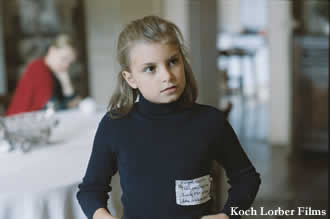 which she lets her mother stroke her fingers as they curl up in bed or the tenderness with which she climbs upon her father’s lap or takes his hand in grave moments.
which she lets her mother stroke her fingers as they curl up in bed or the tenderness with which she climbs upon her father’s lap or takes his hand in grave moments.
Blame It on Fidel is, in the end, (and at the outset, and certainly not only, but also not least) the work of women. Based on the novel by Domitilla Calamai and written by the film’s director Julie Gavras, it was produced by Sylvie Pialat (widow of Maurice Pialat), shot by Nathalie Durand, edited by Pauline Dairou, costume-designed by Annie Thiellement, cast by Coralie Amedeo, and acted by two splendid leads, Julie Depardieu (daughter of Gérard Depardieu) and first-time actor, little Nina Kervel. This is not to diminish the fine work of the executive and co-producers, co-writers, actors, composer, production designer, sound designer and assistant director who happen to be men, nor to squeeze the film into a box, but to commend it as a sensitive and important rendering of, by, and about women in the larger picture of art and politics.
* * * * *
Weak: 1 Star Average: 2 Stars Good: 3 Stars Very Good: 4 Stars Excellent: 5 Stars

